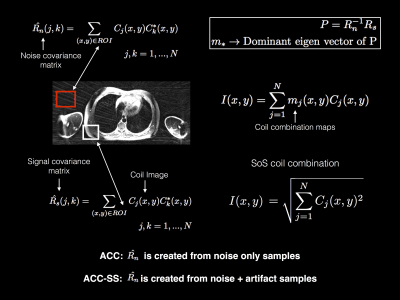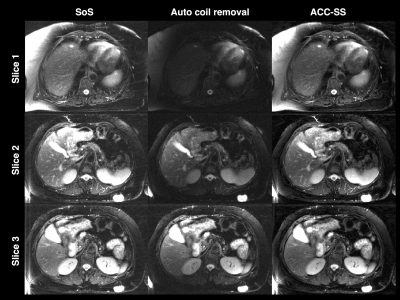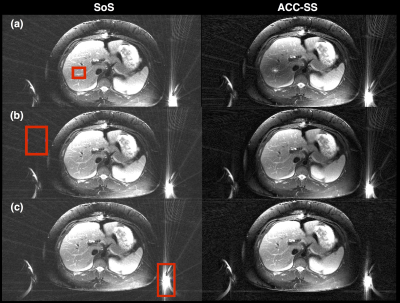0933
Radial streaking artifact reduction using phased array beamforming1Electrical and Computer Engineering, University of Arizona, Tucson, AZ, United States, 2Department of Medical Imaging, University of Arizona, Tucson, AZ, United States
Synopsis
Streaking artifacts can occur in radial MR imaging especially in applications that require large FOVs. In abdomen MRI, the common sources of streaking are unsuppressed fat and the arms with the latter being a particularly problematic source of streaking. The standard approach to mitigate streaking is to identify, either manually or automatically, the subset of coils that are heavily contaminated by streaking artifacts and discard them prior to coil-combination. We present a simple approach to mitigate streaking artifacts that leverages phased array beamforming (spatial filtering) and demonstrate its performance on radial fast spin echo data.
Introduction
Radial k-space scanning is becoming increasingly popular due to its reduced sensitivity to motion and its potential for accelerated imaging. However, when imaging large FOVs, streaking artifacts due to gradient nonlinearities corrupt images even when Nyquist sampling requirements are satisfied1. In practice, a subset of coils in the phased array contribute the bulk of the streaking artifact and the conventional strategy to mitigate these artifacts involves identifying the problematic coils and discarding them before coil combination1-2. This strategy can sometimes lead to excessive loss of SNR when coils are pruned heavily to minimize artifact. Alternative approaches involve weighting the k-space coil data3 or the coil images4 to minimize the effects of the streaks.Phased array beamforming
Our approach to removing streaking artifacts is built upon adaptive phased array channel combination (ACC)5. ACC is based on generating signal covariance (Rs) and noise covariance (Rn) matrices from which channel combination maps are generated. The noise data can be acquired using an auxiliary scan and the signal matrices are typically created from tiling a small rectangular window across the imaging scene to enhance SNR5. As originally presented5, ACC results in an SNR optimizing channel combination but phased array processing can be used for other tasks as well6. Beamforming with phased arrays is a form of spatial filtering that can be used to suppress unwanted signals7. ACC uses beamforming to suppress noise and enhances the SNR. We augment ACC to perform streak suppression (SS), ACC-SS, and this process involves generating the noise covariance matrix from data samples that contain the streaking artifact. An illustration of this process for a N channel phased array is provided in Figure 1. Rs matrices are created from local signal windows (white box) that are tiled across the image. The Rn matrix is created from a region in the background (red box) that contains noise as well as streaking artifact. Eigen-decomposition of R-1nRs can be used to create the channel combination maps. These maps inherit structure that performs interference rejection7 and acts as a spatial beamforming filter which suppresses artifacts. This technique is closely related to the method of signal nulling5 which has been used to suppress unwanted signals such as motion-related artifacts. The Sum-of-Squares (SoS) combination is also defined in Figure 1.Methods and Results
Abdomen data from a 1.5T Siemens MRI scanner were acquired using a radial fast spin echo sequence with ESP: 6.2ms, ETL: 32, TR: 2.43s, FOV: 420mm. Figure 2 compares SoS, ACC, ACC-SS and demonstrates the importance of including the artifacts into the process of generating the Rn matrix. Figure 3 shows the SoS and ACC-SS reconstructions for some sample slices with varying levels of streaking artifacts. Figure 4 shows some example reconstructions obtained using SoS, ACC-SS, and an auto-coil removal method1. The auto-coil removal method depends on the selection of a predefined threshold and the use of a fixed threshold exhibits significantly different performance across the three slices when compared to ACC-SS. Figure 5 shows impact of the selection of the data samples used to form the Rn matrix. In Figure 5(a), Rn is estimated from samples inside the liver. This creates a diffuse spatial null inside the liver due to destructive interference consistent with earlier results5 but leads to poor streak suppression. In Figure 5(b), the samples are extracted from a background region containing noise and artifact and we can see that the resulting ACC-SS reconstruction suppresses artifact as well as the background noise. However, note that there are still some streaks originating from the left arm. In Figure 5(c), the region used to estimate the Rn matrix is selected to cover the whole left arm and the streaking artifacts originating from the left arm are virtually eliminated.Conclusion
We demonstrate that a simple modification in the ACC coil combination framework can be used to suppress radial streaking artifacts. Unlike approaches that rely on coil removal, the proposed approach, ACC-SS, works by using phased array beamforming and offers a balance between artifact suppression and SNR preservation. Future work will involve automating the process of the noise/artifact sample selection as well as assessing the impact of beamforming on anatomical regions of interest.Acknowledgements
The authors would like to acknowledge support from the Arizona Biomedical Research Commission (Grant ADHS14-082996) and the Technology and Research Initiative Fund (TRIF) Improving Health Initiative.References
[1] Xue Y, Yu J, Kang HS, Englander S, Rosen MA, Song HK. Automatic coil selection for streak artifact reduction in radial MRI, 2012, 67, 470-476.
[2] Grimm R, Forman C, Hutter J, Kiefer B, Hornegger J, Block T. Fast automatic coil selection for radial stack-of-stars GRE imaging. ISMRM, 2013, 3786.
[3] Feng L, Chandrana H, Sodickson DK, Otazo R. Unstreaking: Radial MRI with automatic streaking artifact reduction. ISMRM, 2017, 4001.
[4] Kholmovski EG, Parker DL, Di Bella EV. Streak artifact suppression in multi-coil MRI with MRI sampling. ISMRM, 2007, 1902.
[5] Walsh DO, Gmitro AF, Marcellin MW. Adaptive reconstruction of phased array MR imaging. MRM, 2000, 43, 682-690.
[6] Kellman P, McVeigh ER. Ghost artifact cancellation with phased array processing. MRM, 2001, 46, 335-343.
[7] Van Veen BD, Buckley KM. Beamforming: A versatile approach to spatial filtering. IEEE ASSP magazine, 1988, 5, 4-24.
Figures




